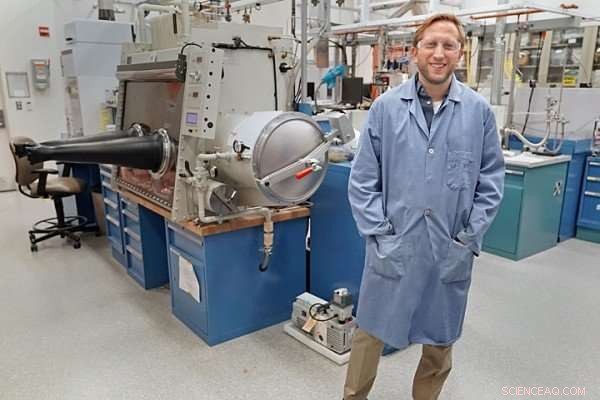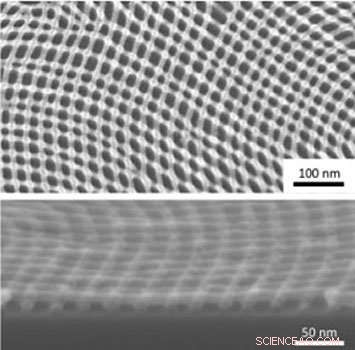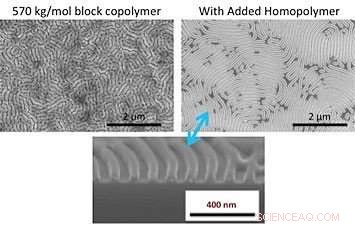Pesquisador discute a automontagem de materiais para fazer diversos padrões em nanoescala
 p O cientista de materiais Gregory Doerk no laboratório de processamento de materiais da CFN. Crédito:Laboratório Nacional de Brookhaven
p O cientista de materiais Gregory Doerk no laboratório de processamento de materiais da CFN. Crédito:Laboratório Nacional de Brookhaven
p Alguns materiais têm a capacidade única de se automontar em padrões e estruturas moleculares organizados. O cientista de materiais Gregory Doerk, do Grupo de Nanomateriais Eletrônicos no Center for Functional Nanomaterials (CFN) - um Departamento de Energia dos EUA (DOE) Office of Science User Facility no Brookhaven National Laboratory - tira proveito dessa capacidade em materiais chamados de copolímeros em bloco. Usando esses materiais de automontagem, que têm cadeias de duas ou mais moléculas distintas ligadas entre si por ligações químicas, Doerk dirige a formação de tais padrões e estruturas em nanoescala. O objetivo final é alavancar essas arquiteturas em nanoescala para controlar as propriedades dos materiais para aplicações, incluindo conversão e armazenamento de energia solar, catálise, e óptica. p
A automontagem ganhou muita atenção recentemente como uma abordagem de nanofabricação. Em que difere da abordagem tradicionalmente usada?
p Em termos gerais, existem duas plataformas para nanofabricação. Uma plataforma é a nanofabricação de cima para baixo, que é a abordagem tradicional usada para fazer chips de computador e outros microeletrônicos. A luz é usada para criar padrões que são entalhados em placas de silício. A técnica de padronização usando luz é chamada de litografia óptica. A outra abordagem é a nanofabricação de baixo para cima, ou automontagem molecular. As propriedades dos materiais são codificadas em suas interações fracas, que fazem com que certos materiais se juntem e formem configurações específicas - como os tijolos de Lego, mas os tijolos são construídos por conta própria para formar alguma estrutura.
p A litografia é geralmente mais rápida - e produz as estruturas projetadas de maneira mais confiável - mas requer cara, ferramentas complexas. A automontagem costuma ser mais lenta e menos preditiva, mas é barata e pode ser mais fácil. Existem maneiras de combinar as duas abordagens, e essa combinação é conhecida como automontagem dirigida. Materiais de automontagem, como filmes finos de copolímeros em bloco, são solicitados usando modelos padronizados por litografia padrão. A automontagem direcionada aprimora os processos de fabricação atuais, expandindo o espectro de geometrias padrão que são possíveis, e reduz o custo de nanofabricação.
p
Sua pesquisa de automontagem está focada em copolímeros em bloco. O que torna esses materiais tão especiais?
p Desde a década de 1950, as pessoas têm usado copolímeros tribloco (três polímeros unidos) em materiais como borracha sintética. A maioria dos polímeros não se mistura. Tentar misturar polímeros é como tentar misturar óleo e água.
p Mas em copolímeros em bloco, as cadeias de polímero são quimicamente ligadas umas às outras. Por exemplo, cadeias de copolímero dibloco (dois) são unidas por meio de uma ligação covalente. Essa ligação frustra seu impulso de "demixar". Em vez de, se os copolímeros em bloco receberem energia para mobilizar suas cadeias - por exemplo, por recozimento (aquecimento) do filme de polímero em uma placa quente acima de sua temperatura de transição vítrea (quando um polímero faz a transição de um disco rígido, material vítreo para um macio, emborrachado) - as cadeias serão reconfiguradas e montadas em domínios separados por fase em nanoescala. Esses domínios são ordenados em padrões de nanoescala com base em características inerentes do copolímero em bloco. Por exemplo, digamos que temos dois polímeros, A e B, unidos (copolímero dibloco). O comprimento do bloco A em relação ao comprimento de ambos os blocos, o comprimento total das cadeias de polímero, e as propriedades dos polímeros e a força de sua interação (quanto os polímeros querem separar) governam o tamanho e a morfologia, ou forma, das estruturas resultantes. Se as cadeias forem muito curtas ou suas interações repulsivas forem muito fracas, os polímeros vão se misturar, fazendo com que o estado ordenado se torne um estado desordenado e, portanto, nenhum padrão se formará.
p Na CFN, uma parte importante do nosso trabalho é transferir os padrões e estruturas feitas por meio da automontagem, litografia de feixe de elétrons, ou litografia óptica em nossa Instalação de Nanofabricação em outros materiais para controlar as propriedades dos materiais. Um ótimo exemplo disso é o trabalho do diretor Chuck Black da CFN usando copolímeros em bloco para criar um padrão automontado que serve como um modelo para gravar cones nanométricos em superfícies de silício. Com essas nanotexturas, as superfícies de silício se transformaram de espelhos reflexivos em totalmente pretas. Essa é uma maneira de usar copolímeros em bloco.
 p O comprimento dos blocos de polímero (linhas onduladas vermelhas e azuis) e a força de sua interação determinam a forma dos padrões resultantes na automontagem do copolímero de bloco:(da esquerda para a direita) esferas, cilindros, e lamelas (folhas). Crédito:Gregory Doerk
p O comprimento dos blocos de polímero (linhas onduladas vermelhas e azuis) e a força de sua interação determinam a forma dos padrões resultantes na automontagem do copolímero de bloco:(da esquerda para a direita) esferas, cilindros, e lamelas (folhas). Crédito:Gregory Doerk
p Mas queremos expandir a gama de coisas que podemos fazer com a automontagem - e, portanto, a gama de aplicações. Diversificar os padrões possíveis com a automontagem de copolímero em bloco é uma grande parte da minha pesquisa.
p
Você conseguiu expandir essa gama?
p Uma maneira de me interessar em expandir o que podemos fazer por meio da automontagem é criando réplicas inorgânicas das estruturas automontadas. Podemos realizar essa replicação por meio de um processo denominado síntese de infiltração.
p Por exemplo, say you have a block copolymer that forms lamellae (stripes) perpendicular to a substrate. Using an atomic-layer-deposition tool, it is possible to infiltrate those lamellae with a metal oxide and then remove the polymer, leaving behind metal oxide lines in a pattern determined by the polymer self-assembly. It is even possible to perform self-assembly and replica formation on top of previous replicas in an iterative way. What is really interesting is that the topography from the initial layer actually acts as a template dictating how polymer domains in the next layer line up. In the case of a second layer of lamellae perpendicular with the substrate, a self-assembled nanomesh is naturally created.
p
What other ways can you expand the range of self-assembled patterns?
p One area in which I have collaborated with other members of the Electronic Nanomaterials Group is to study the blending of block copolymers that form lamellae with block copolymers that form cylinders. The really cool thing we learned is that you can precisely control which of these two patterns emerge in different areas of a substrate through an approach we call selective directed self-assembly. In a diblock copolymer, one of the blocks may be relatively more hydrophobic (water repelling) and the other may be relatively more hydrophilic (water attracting). So if a chemical pattern was made up of alternating hydrophobic and hydrophilic lines, the block copolymer molecules would self-assemble accordingly. By changing the spacing and width of the chemical line gratings (patterns) on the substrate, we were able to direct the self-assembling blocks into specific arrangements—either forming striped patterns (lamellae) or hexagonal dot arrays (cylinders). We can locally adjust the spacing and linewidth of the underlying chemical template to precisely control exactly where these line or dot patterns form on the same substrate, também.
p
How big are the features of these self-assembled nanoscale patterns?
p Block copolymers typically self-assemble into ordered periodic structures with a tunable repeat spacing between around 25 to 50 nanometers. Na realidade, one of the projects I am currently working on is to increase the size range over which block copolymers form patterns. There is a lot of work in the scientific community to go to smaller and smaller sizes (approaching a few nanometers) for lithographic applications such as making computer chips. But for certain applications, you need larger sizes.
 p Plan view (top) and cross-sectional (bottom) scanning electron microscope images of an inorganic nanomesh created through iterative self-assembly and infiltration synthesis. Credit:Gregory Doerk
p Plan view (top) and cross-sectional (bottom) scanning electron microscope images of an inorganic nanomesh created through iterative self-assembly and infiltration synthesis. Credit:Gregory Doerk
p Por exemplo, the wavelength range of visible light is about 400 (purple) to 700 (red) nanometers. Even 400 nanometers is still about 10 times larger than the approximately 40-nanometer length scale possible with most block copolymers. Como resultado, light does not "see" the individual features of block copolymers.
p Contudo, patterns with features closer to 200 nanometers in size can influence light in new ways, and I am working to scale block copolymer assembly to these sizes. One exciting application is using this approach to make "structural colors." Colors are typically made using dyes or pigments. Contudo, structural colors emerge from the way the light interacts with the nanomaterial—and so potentially one could make new types of lower-power displays through structural color.
p Infelizmente, the process of forming patterns from block copolymers slows drastically, and even stops altogether, for these larger sizes. The development of self-assembled patterns is impeded by defective structures that form at the start of self-assembly. For these defects to "heal, " the block polymer must reconfigure, which involves pulling one chain through the domain of the other polymer, overcoming a large energy barrier to do so. As the size of the polymers increases, the energy barrier goes up exponentially—so exponentially slower healing!
p
Have you come up with any solutions to overcome this challenge?
p My colleagues and I found that blending small-molecular-weight homopolymers (polymers made up of the same type of molecules) with the block copolymers makes it easier for the block copolymer chains to move around. Adding homopolymers promotes dramatic increases in the size of well-ordered pattern areas, ou "grãos". Contudo, this addition alone does not let us form patterns with larger-size features from block copolymers. We also need to anneal the materials in a solvent vapor. Solvent vapor annealing involves putting a volatile solvent in the region of the diblock copolymer, causing the polymer film to swell. As the polymer film swells, the solvent molecules intersperse between polymer chains. This process has a plasticizing effect, making it easier for the polymer to move. So both mixing the block copolymer with a homopolymer and swelling it with a solvent are needed to speed the formation of large-scale patterns.
p After annealing, we image the resulting patterns with scanning electron microscopes at CFN. We also perform x-ray scattering experiments at the Complex Materials Scattering beamline at Brookhaven Lab's National Synchrotron Light Source II [also a DOE Office of Science User Facility] to get a measure of the periodicity during the annealing process so we can determine how quickly the material self-assembles into an ordered pattern.
p
How do all of the different self-assembled patterns you generate translate to possible applications?
p The work we do at CFN establishes the basis for producing new materials. Por exemplo, consider the mesh pattern I described. My colleague Chang-Yong Nam and I are working on making a mesh of zinc oxide nanowires through infiltration synthesis of block copolymers. Zinc oxide is a versatile semiconducting material, and these nanowires have a lot of surface area, making them attractive for a number of applications—including photoelectrochemical water splitting (a way of converting sunlight into fuel by splitting water into hydrogen and oxygen). These semiconducting nanowires are also very responsive to environmental cues like light or chemicals. Given their large area uniformity, the meshes could be easily integrated into widely deployable gas sensors.
 p Without blending, the size of grains (single-color regions) of a diblock copolymer with a molecular weight of 36 kilograms/mole barely changes with thermal annealing over time (top row). Blending the block copolymer with homopolymers increases the grain size and speeds up the ordering process (bottom row). Credit:Gregory Doerk
p Without blending, the size of grains (single-color regions) of a diblock copolymer with a molecular weight of 36 kilograms/mole barely changes with thermal annealing over time (top row). Blending the block copolymer with homopolymers increases the grain size and speeds up the ordering process (bottom row). Credit:Gregory Doerk
p
How did you come to join CFN?
p After graduate school, I completed a postdoctoral appointment working at IBM in California. It was there that I learned about block copolymers, using them to make patterns for microelectronics. I did that for three years, and then in 2013 I joined a research group at HGST, a subsidiary of Western Digital that sells hard disk and solid-state drives. Inicialmente, I worked on a project to create patterned nanoscale magnetic media onto which data is written to and read from, in order to enhance data density and stability.
p Following that project, I moved into another area that was not very research oriented. At about this time, the current CFN Director, Chuck Black, gave a talk at HGST. Chuck's talk piqued my interest in CFN, and soon thereafter a position that very well fit my skills opened up. I applied, and joined CFN in 2015.
p
What was it like coming from industry to a national lab setting?
p It definitely takes some getting used to. There is a lot less pressure in some ways but more pressure in other ways. Na CFN, you are expected to develop a lot more on your own as far as what direction you need to pursue on the basis of what is valuable to the lab. Na industria, the goals of the project are clear, and there are deliverables to keep you on the narrow path to achieving those goals. This is not to say that I did not do exploratory research for a portion of my time in industry.
p The other difference at CFN is that I am more involved with the academic and industrial community at large. I have to manage my time so that I can perform my own research and help users with their research. I find it really cool that researchers from all over the world come to CFN. The talent and expertise of the staff are what make the CFN so great. The staff know backwards and forwards what they are doing in the areas they specialize in, and they are dedicated to helping others.
p
What are some of the ways you have helped users?
p I regularly show users how to do block copolymer self-assembly and the etching process to transfer patterns into a substrate. Some users have employed these patterns as superhydrophobic textures to manipulate the flow of liquids in microfluidic devices, por exemplo. Em muitos casos, I help users develop a process when they need self-assembled patterns of varying sizes or shapes, to be applied to different substrates.
 p A comparison of scanning electron microscope images after solvent vapor annealing of a large block copolymer (top left) and the same copolymer with added homopolymer (top right) shows that the homopolymer can significantly improve pattern quality. The bottom image is a cross-sectional image of the top right sample. Credit:Gregory Doerk
p A comparison of scanning electron microscope images after solvent vapor annealing of a large block copolymer (top left) and the same copolymer with added homopolymer (top right) shows that the homopolymer can significantly improve pattern quality. The bottom image is a cross-sectional image of the top right sample. Credit:Gregory Doerk
p I also help with the lithographic patterning of unusual materials. Por exemplo, one user I am working with is trying to pattern protein hydrogels, looking at how they mechanically respond to swelling and de-swelling to understand how they might operate if injected into the body. Such protein hydrogels could have applications in biosensing, entrega de drogas, and wound healing.
p Some users are interested in solvent vapor annealing, which is a very tricky process to control. So I am building a system with feedback control that can be set to maintain a solvent fraction of any given solvent. De outra forma, if the amount of solvent varies over time, the self-assembly might not work at all (too little solvent) or result in a disordered state (too much solvent).
p
How did you become interested in research?
p As an undergraduate at Case Western Reserve University, I majored in chemical engineering. One of my summer internships involved doing fuel cell work at a research lab. This internship led to another one at a fuel cell start-up, where I worked on sensors and solar cells. These internships gave me the opportunity to come up with ideas of my own and try different things. This exploration spurred me to pursue a doctoral degree at the University of California, Berkeley, where I continued my studies in chemical engineering.
p I also think my undergraduate studies in philosophy, which I minored in, gave me a new understanding of the way science works. I really enjoyed reading about the philosophy of science, including books like Kuhn's The Structure of Scientific Revolutions. I learned how the views we often have are naïve or not accurate. There are lots of things people get wrong for a long time. But that does not mean they were not learning. Science is not perfect—but that is okay.
p I was not the kid who grew up knowing he wanted to be a scientist. I liked philosophy and delving into critical thought. But I began to realize there is a lot of commonality between philosophy and science—in both fields, the aim is to gain knowledge about the world around us. But science is better because you can actually test things!




